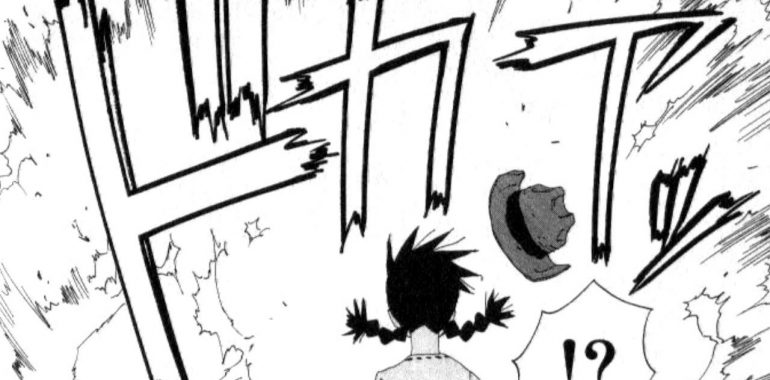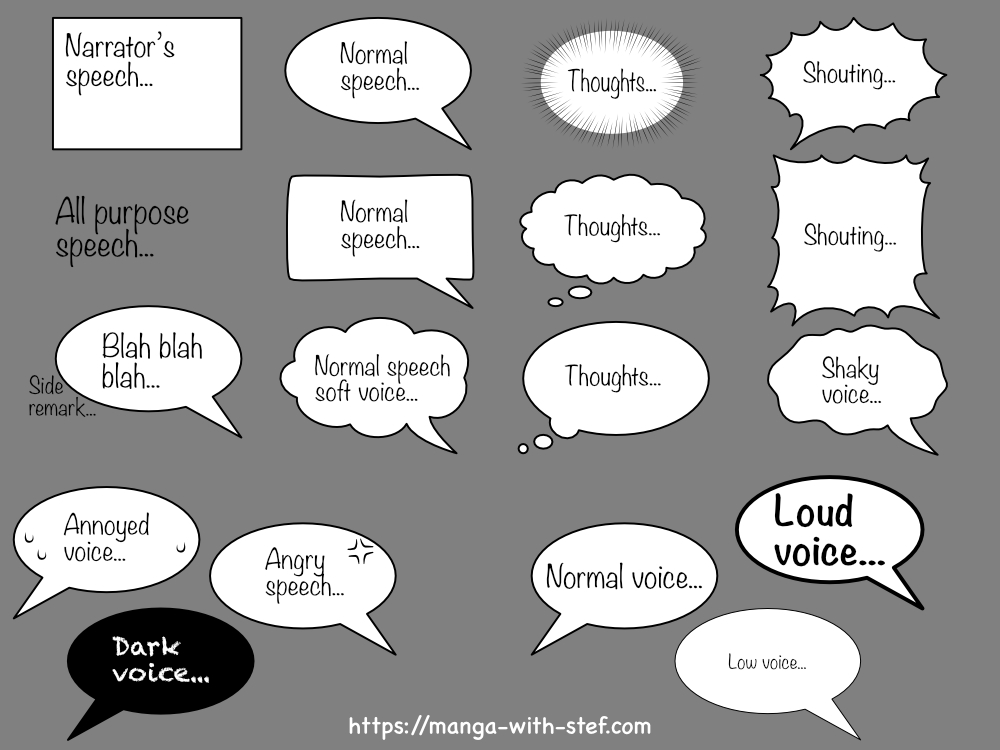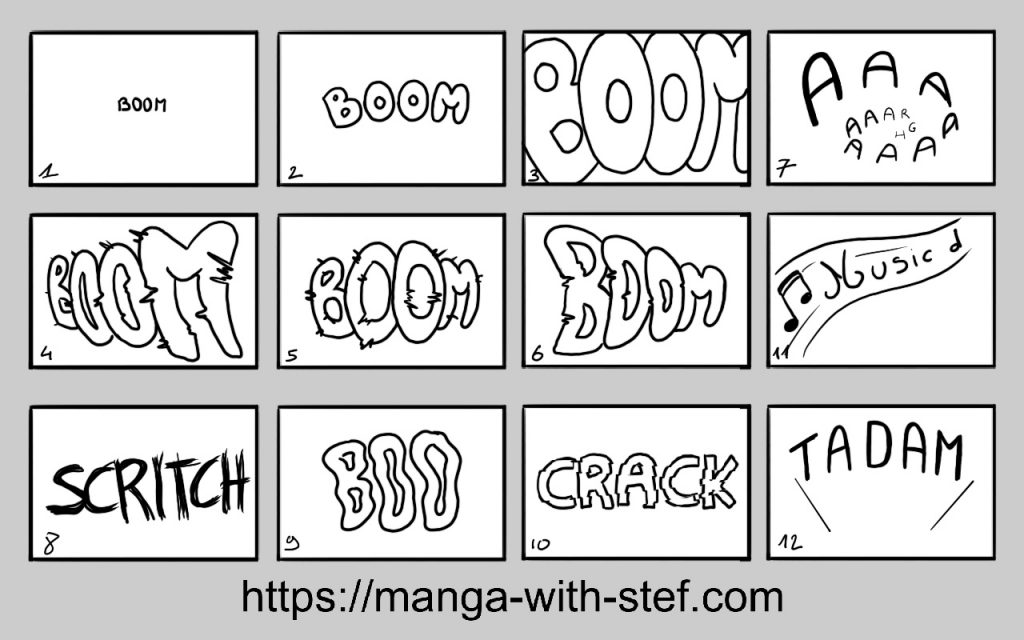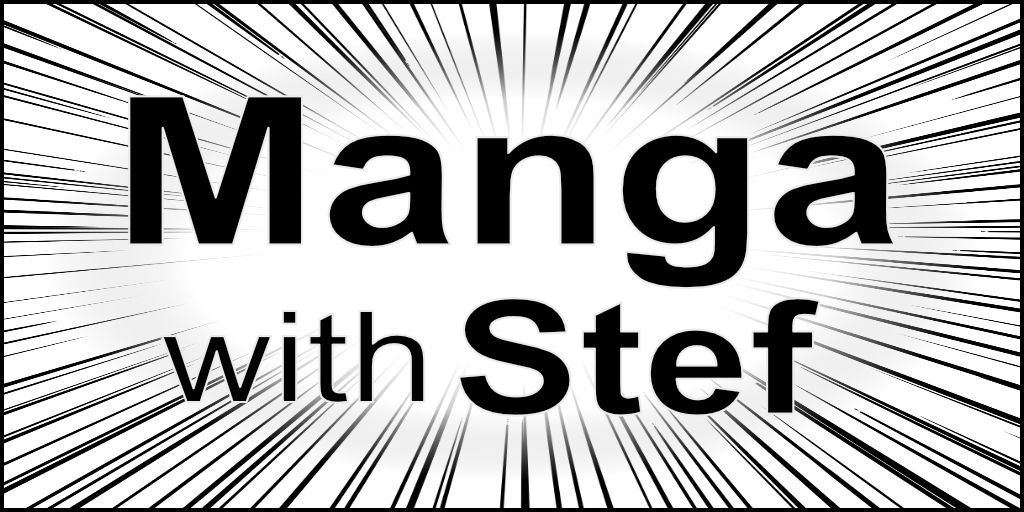Adding Sound Effects to Your Manga

Adding Sound Effects to Your Manga
As a graphic novel, manga uses different artifices to give readers the impression of sounds, sound effects and voices. These artifices are based on two elements: onomatopoeias and text bubbles. Onomatopoeias are textual representation of sounds and noises, and text bubbles are used to provide a voice to the characters.
As onomatopoeias and text bubbles are graphical elements, manga and comics artists have found many ways to play with their graphical properties to render different sounds and voices and sound effects.
And as we, as readers, have been accustomed to these artifices through our readings, our brains are able to transparently translate them into something auditory and emotionally relatable.
We will have a look at the different mechanisms available to around text bubbles and onomatopoeias.
Bubbles
Bubbles is a graphical artifice developed to represent voices within a manga.
A bubble is made of 3 elements:
- the shape of the bubble with its outline and tail (the part pointing to the speaker),
- the typeface used in the bubble and its size and weight,
- the text of the bubble and its punctuation.
As a manga artists, it will be essential that you understand how these 3 elements are working. With good control over them, you will be able to use bubbles to render each characters voices and emotions.
Here are some common example of bubbles:

The shape of the bubble
You could imagine bubbles of every shape you want. But you have to be aware of the standards used in manga to avoid confusing your readers.
Here some of the most commonly used bubble shapes:
- Square bubbles with no tail: Manga artists generally use these bubbles for narrator’s speech. The narrator is (in most cases) someone outside of the manga story who states facts and things important (or not) for the reader. The objective of narration is generally to summarise a chain of several events in a few sentences.
- Oval Bubbles with clean outlines and a pointy tail – Manga artists use these bubbles as the voice of the characters. This is the character speaking out normally in a conversation or to himself.
- Bubbles with circles for the tail – These bubbles are denoting thoughts and reflection, something that the character is not speaking out. You will also find in many manga bubbles with a shape constituted of many radial lines to denote thoughts (3rd bubble on the top row).
- Spiky bubbles: Artists use these bubble to indicate that a character is shouting or speaking angrily.
- Bubbles with wobbly or cloud-like outlines: Some artists will play with the shape of the bubbles to add some further voice effects. A wobbly outline will signify a shaky voice, either trembling or crying. A cloud-like bubble will render a more eerie and dreamy voice.
- It is also quite frequent to find text without bubbles. You can use that kind of text for different purposes, like narration or thoughts…
The typeface, its size and weight
Even though in many manga the typeface (font) used in speech bubbles is generally the same throughout the entire story, some artists use specific typefaces to render some voice effects.
For instance, you can emulate some characteristic voice tones or language accents. Using a gothic font can render a germanic accent. A handwritten font will emulate a singing tone or a flowery voice.
Note that this practice isn’t standard in graphics novels. The effect you will therefore achieve using it will be random and depend on the reader’s past experiences and imagination. But for sure seeing a different font for a character will force the brain to imagine that this character has a specific voice.
You can also vary the typeface’s size and weight (light, normal, bold) to stress some words and indicate the volume of the voice. In general, you will use a small light font to indicate that a character whispers or mutters. And you will use a big bold font to indicate that your character is stressing out something or speaks loudly (without shouting).
The text and its punctuation
The last part of a bubble you can play with is its text and its punctuation.
At first, You can use the text itself to display some of the characteristics of your character’s speech. This can be language quirks with the repetition of some words. Or an indication of the speech register with slang or formal language to indicate social origins or education of the character. It can also be the use of some words specific to a regional dialect… Don’t overdo it, though, as if it makes the text too complicated to read you will end wearing out your readers.
Punctuation is something people learn to interpret at school. Commas lead to a short pause, colons to a stop, suspension points to an interruption of the speech… Playing with punctuation within the text is therefore a way to achieve speech rhythm and to represent emotions. Someone under stress will speak quickly with few pauses. Someone exhausted might pause every word or syllable. It can also emulate some of the character’s speech characteristics if this character has a specific speech rhythm.
Finally, the way you distribute the text over bubbles and panels is also a manner to show the tone and the feelings of characters. Having a lot of text for a character within a single bubble can make him/her sound talkative. Spreading the text over multiple bubbles can give the impression the character is stressing words, or having difficulties speaking.
Other artifices
Manga artists are also using some artifices specific to manga to induce emotions and tone of the voice.
For instance, some artists will add markers like drops to a bubble to emulate someone under stress, or a pulsing vein to indicate someone talking angrily.
It is also common to find a side text to some bubbles indicating that someone is muttering something, or is making a side remark.
The last example is the use of a black background for the bubble to signify a dark voice for instance.
Onomatopoeia
Manga and comics artists use onomatopoeias to represent sounds, noises.
Again, as onomatopoeias are graphic representation of sound and noises. They therefore have some graphical properties that you can use to add sound effects to your manga:
- The text, which represents approximately the sound or noise
- The graphics, which brings a visual idea of the effect the sound has or brings to our minds
Onomatopoeia text
The text of onomatopoeia is a textual representation of the sound or noise. This text must not be changed if you want your readers to understand them.
The reason is that the connection between the text of the onomatopoeias is cultural. Readers acquire an understanding of what these onomatopoeias represent through their readings. The onomatopoeia might also be part of their language and be used in everyday’s discussions.
Changing that text might therefore lead to misinterpretation, or let your readers clueless. You might have seen that when reading sound effects in Japanese manga. The DON and DOKIN and DOKI DOKI might have made no meaning for you at the beginning.
For instance when reading “bang bang!” people will generally recognise the sound of a gun being fired. If you change this text to “pon pon” for instance, nobody will understand that this is a gun firing.
One exception is if you intentionally use another text to create surprise and curiosity in the mind of your reader. For instance using “pon pon” in place of “bang bang” to make it sound like the gun has a problem. This can be used therefore to create some kind of funny effect.
The other way you can alter the text of an onomatopoeia is by duplicating some of the letters. An example would be using “BOOOOM” instead of just “BOOM” to amplify the sound of an explosion.
Onomatopoeia graphics
We have seen that there is little room to play with the text of the onomatopoeia. This means that to create sound effects in your manga you will have to act on the graphical part of the onomatopoeia.
You can for instance:
- Modify the size and weight of the typeface used for the text. This will have an effect on the way the readers will perceive the volume of the sound. Smaller thinner typefaces will be used for discreet sounds, and larger bolder fonts for loud sounds.
- The typeface itself can be modified to induce certain emotions or feelings. You can use round shapes, sharp shapes, spiky shapes… to create different effects.
- Finally, you can also play with the overall shape of your onomatopoeia to create spatial positioning.
Here are a few examples:

Here is a quick description of these different examples:
- 1, 2 and 3 show how you can alter the size of the typeface to influence the perception of the loudness of the sound.
- 4, 5 and 6 show how you can give an indication of the position of a sound.
- 7 shows how you can indicate a sound source being mobile.
- 8, 9, and 10 show how the typeface used can add sensations to a sound. The repeated strokes emphasise the scratching sound (8). A wobbly shape will make the sound wobble (9). And a broken glass effect will image something being broken (10).
- 11 is an example of something more abstract. Here for instance we have a source producing music. This approach is more advanced and uses different artifices to induce its effect, with notes…
- And finally, 12 shows a cartoony sound effect with a triumph jingle.
Be relatable
As I have indicated, bubbles and onomatopoeias follow some cultural standards. Therefore try to stick to these standards whenever possible to ensure a good understanding of the sound and sound effects by the readers of your manga.
You can of course try to deviate from these standards to create some specific sensations. But make sure to give context and meaning to that deviation so that your readers can understand it as you expect.
Overall, you can see that even though manga do not have audio in themselves, there are many ways to bring auditory sensations to your readers. Do not hesitate to read your favorite manga again to see how these different techniques are being used.
Do not hesitate if you want to ask questions or share your experience. And do not hesitate to like and share this article if you found it useful.
See you!
Stef
